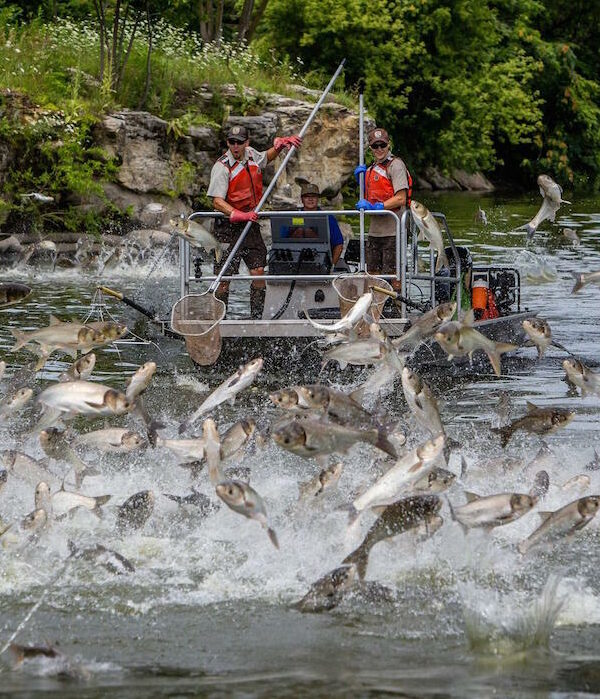Sections of this article are taken directly from the following sources, and from direct communications with Fisheries Chief Bobby Wilson of the Tennessee Wildlife Resources Agency.
- http://www.asiancarp.us/index.htm
- http://www.bizjournals.com/memphis/news/2014/07/23/asian-carp-target-of-new-mississippi-development.html
Tennessee is experiencing a significant expansion and growing problem of Asian carp in our rivers. This article is an effort to bring the reader up to speed on the issue. Stay tuned for future updates where we will be discussing potential solutions to this problem.
“Asian carp” refers to several species of related fish originating from Asia. Two species of Asian carp—the bighead and silver carp—were imported into the southern United States to keep aquaculture facilities clean and to provide fresh fish for fish markets. Bighead and silver carp escaped from Arkansas fish farms into the wild in the 1970s and have been swimming northward and southward ever since, overwhelming much of the Mississippi River drainages (including the Tennessee and Cumberland River systems).
In some areas like the Illinois River, the Asian carp now comprise more than 95% of the biomass.
Bighead and silver carp are voracious eaters. This is a problem because the diet of Asian carp overlaps with the diet of native fish in the Tennessee, Cumberland, and Mississippi Rivers. Asian carp consume plankton—algae and other microscopic organisms—stripping the aquatic food web of the key source of food for native fish. Averaging 30-40 pounds, some Asian carp can grow to be over 100 pounds. An Asian carp is capable of eating 5-20 percent of its body weight each day.
Between 1991 and 2000 the Asian carp population dramatically increased as the fish spread throughout the Mississippi River drainage. Between 1994 and 1997 commercial catches of bighead carp in the Mississippi River increased from 5.5 tons to 55 tons. Today, commercial fishers in the Illinois River regularly catch up to 25,000 pounds of bighead and silver carp per day. The commercial value of Asian carp is quite low and much less valuable than the native fish they replaced.
In addition to causing ecological harm and negatively impacting sport fishing, the silver variety of the Asian carp has caused direct harm to people. The silver carp is skittish and easily startled by the sound of a boat motor. The sound causes the fish to leap as high as ten feet out of the water. They land in boats, damage property, and routinely injure people.
While both species of carp are of concern in Tennessee, the silver carp is of greatest concern due to its potential to negatively impact native fisheries and injure outdoor recreationists.
How Can We Stop Carp?
There are currently discussions taking place to utilize methods that can help stop the advancement of Asian carp. Currently, Asian carp are present in the Tennessee River system as far upstream as Guntersville reservoir in the Tennessee River system and are present as far as Old Hickory Lake in the Cumberland River system. They are also present in Reelfoot Lake.
Interestingly enough, the U.S. Fish and Wildlife Service, with assistance from Tennessee Wildlife Resources Agency, Alabama Department of Conservation and Natural Resources, and Mississippi Department of Wildlife, Fisheries and Parks, have recently been using environmental DNA, commonly referred to as eDNA, as a surveillance tool to try to find out if DNA from bighead or silver carp is present in certain sections of the Tennessee River. eDNA is one of the newest surveillance tools used by these agencies to monitor and track Asian carp in certain waterways. However, there are also limitations on what eDNA can tell researchers about Asian carp.
eDNA has been used as an early detection surveillance tool since 2009. It provides information about whether Asian carp DNA is present in water samples. What it doesn’t tell researchers is if the genetic material came from a live or dead fish, one fish or several, or if the eDNA may have been transported from other sources (e.g., navigation vessels or fish-eating birds). Due to the two-week sample processing time, eDNA cannot yet provide precise, real-time information about where Asian carp might be.
This species is notoriously difficult to find in waterways if the population is very low. The eDNA technique is much more sensitive than other standard fishery sampling gear, and is useful for early Asian carp DNA detection and to identify distribution patterns of DNA when the fish are low in abundance. A positive eDNA result tells researchers if Asian carp genetic material is present in an area, then that area may be a good place to use other sampling tools, such as netting, to look for signs of live Asian carp. For example, despite over two years of eDNA sampling, hundreds of hours of monitoring efforts and tons of fish harvested, only one Asian carp has been captured in the Chicago Area Waterways above the electric barriers in the Chicago Sanitary and Ship Canal.
Tennessee River Carp Testing
In the Tennessee River system, test results indicated the presence of silver and bighead carp eDNA in Pickwick, Wilson, and Wheeler reservoirs (biologists already know that they are present in Kentucky reservoir so they did not test there). The “leading edge” appears to be in Wheeler reservoir.
Another potential control strategy could involve commercial fishermen catching these fish and selling them to processing facilities. Asian carp flesh has many uses that include, but that are not limited to Surimi (also known as Artificial crab meat and as a filler in mixing and preparing processed fish sticks), whole fish to be shipped to China, fish filets (Asian carp meat is very mild and tasty but extremely boney like all carp species), fertilizer, fish meal, and pet foods derived from fish meal.
A 9 member task force, including myself, has been created by an act of the General Assembly this past legislative session (HB1821 and SB1753 were passed and Gov. signed creating Public Chapter 949 http://share.tn.gov/sos/acts/109/pub/pc0949.pdf).
Purpose as stated by the legislation is “to review the detrimental effects of invasive Asian carp, and recommend any necessary statutory revisions that should be made to protect the waterways and native species of this state from any such detrimental effects”.
Serving on the task force are the following:
Rep. Tim Wirgau—Chair
Senator Mark Green—bill sponsor
Rep. Jay Reedy—bill sponsor
Rep. Joe Pitts
Senator Mike Bell
Senator Ed Jackson
Jeff Griggs—former TWRA Commissioner and chair
Ben Duncan—commercial fisherman
Mike Butler—CEO, Tennessee Wildlife Federation




